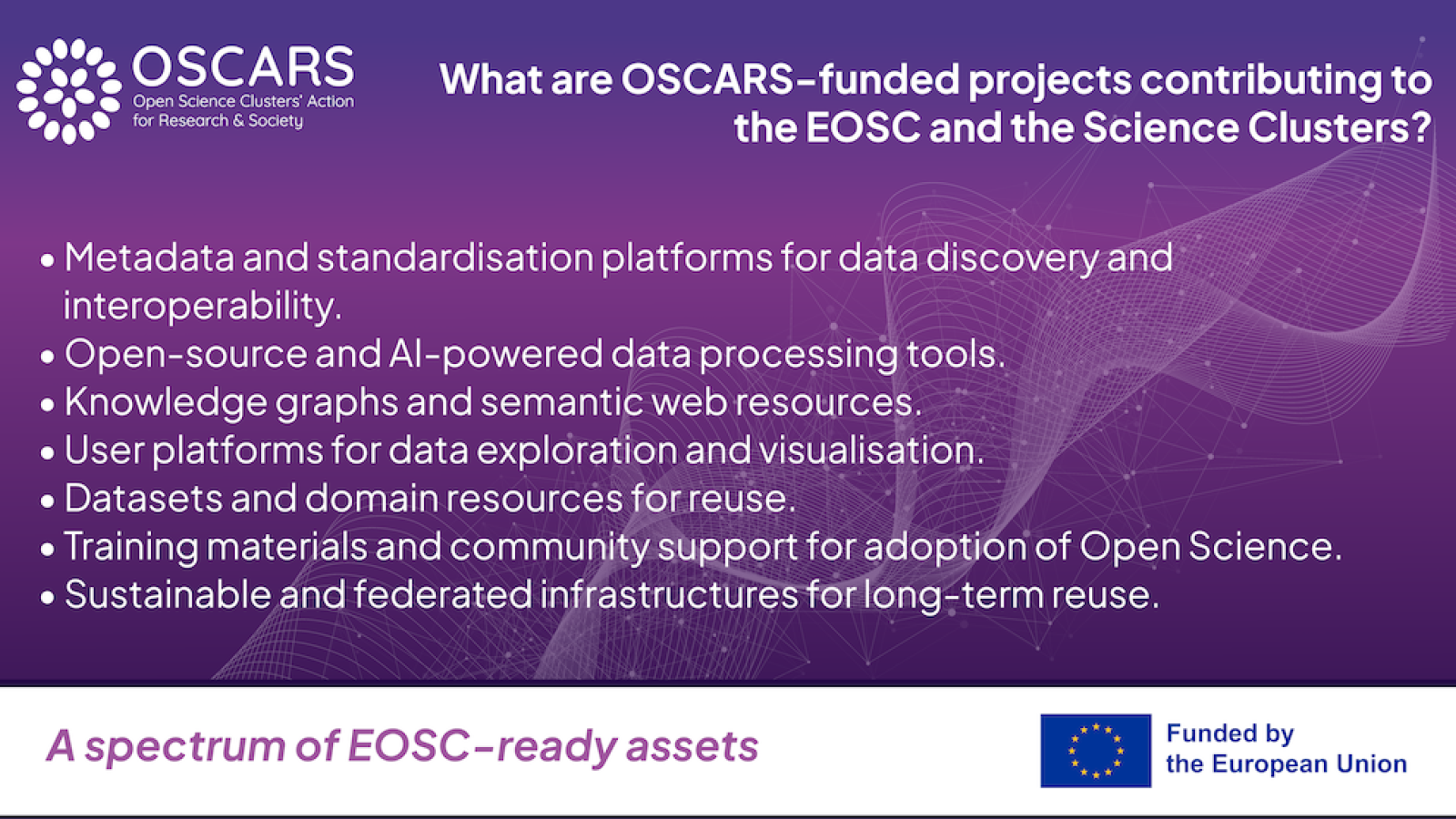
In response to a questionnaire shared in the first half of 2025, the Open Science projects funded via the 1st OSCARS Open Call have articulated what they consider their most valuable assets to be included in the European Open Science Cloud (EOSC) and the Science Clusters upon project completion. These assets refer to a wide variety of disciplines and innovations, encompassing software tools, knowledge graphs, metadata solutions, training resources, and domain-specific data services. The text below gives an overview of these contributions.
OSCARS funded projects' assets across the Data Lifecycle
The assets developed by OSCARS-funded projects can be classified along the research data lifecycle. They start with how data is described through metadata and interoperability solutions, move to how it is processed with software and domain-specific tools, then to how it is structured and linked via knowledge graphs and semantic technologies. From there, the focus shifts to how data is made accessible through user platforms, what resources and datasets are provided in specific domains, and finally how scientific communities are supported through training, best practices, and adoption services.
Projects begin by addressing the foundations of metadata and interoperability, through enrichment and standardisation platforms such as AMIS and CDIF-4-XAS for X-ray spectroscopy data, or through cross-domain harmonisation efforts. Notably, ONTOLISST develops ontologies and controlled vocabularies to enable semantic annotation in the social sciences, while mTeSS-X works to align metadata across federated training portals in STEM and environmental sciences, improving discovery and interoperability of resources.
Building on this foundation, a wide range of software and processing tools has emerged. Open-source platforms provide AI-based data curation, image analysis workflows, and domain-specific pipelines. Examples include BIO-CODES for bioimaging data standardisation, FAIR-EO for AI-driven analysis of Earth observation data, and ioChem-BD for computational chemistry data management.
At the next stage, semantic web and knowledge graphs strengthen interoperability by linking and structuring data in machine-actionable ways. Several projects have advanced Linked Open Data resources and domain-specific ontologies, including DraCorOS, EHRI-KG and ONTOLISST in the humanities and social sciences, or SemantyFish in the life and environmental sciences. These resources ensure that data can be more effectively discovered, integrated, and analysed across domains.
Once structured, data becomes accessible through user platforms for exploration and visualisation. Projects such as CASTAL, which supports analysis of socio-environmental transitions, and AQUANAVI, designed for aquatic research infrastructures, offer interactive environments that make complex datasets more intuitive and usable.
Complementing these efforts are projects delivering datasets and domain resources themselves. Examples range from FAIRY, which provides yeast regulatory network data, to HOMEROS, which integrates multi-hazard environmental observations, including geodetic and hazard monitoring datasets. These contributions provide concrete domain-specific assets ready for reuse.
Finally, sustainability depends on training and community support. Initiatives such as mTeSS-X supply catalogues of training materials, while CDIF-4-XAS and PRIVAGAMS contribute best practice documentation. Other projects emphasise community adoption of Open Science, from OSPARK’s support services, to targeted outreach in specific contexts, such as PNU-OpenLab for Ukrainian institutions, or FAIRFUN4Biodiversity for genomics communities.
Together, these phases highlight how OSCARS funded projects contribute across the entire lifecycle of data, from description and processing to structuring, access, reuse, and community empowerment, ensuring that their assets become lasting components of the European Open Science ecosystem.
Thematic and infrastructure Contributions for a sustainable interdisciplinary framework
Several OSCARS funded projects contribute to reinforcing both disciplinary and cross-disciplinary research infrastructures across domains. In the humanities and social sciences, contributions to CLARIN and DARIAH services - through projects such as ParlaCAP and DraCorOS - support language resources and digital humanities corpora.
Others focus on building federated data management environments, such as MADDEN and Streamlining open data policies with Rucio data management framework, which implement the Rucio framework to catalogue and provide FAIR support for both open and embargoed data.
In astronomy, FSD aligns solar data with Virtual Observatory standards to ensure interoperability, while FIESTA develops interoperable workflows for image analysis that bridge astronomy, microscopy, and environmental sciences.
Projects also target sensitive or restricted data, with ARTICYST improving healthcare data frameworks, PRIVAGAMS enhancing histopathology data management, and the Open and FAIR Integrated Phenology Monitoring System establishing open yet privacy-conscious solutions for environmental monitoring.
Sustainability and long-term reuse are central to all projects funded under the OSCARS Open Calls. Each initiative ensures that its outputs - whether software, data, or services - remain accessible and impactful beyond the project’s lifetime, notably through APIs, public web portals, and integration within EOSC nodes and ERICs.
Projects such as Fragalysis Cloud, FAIR-EO, DraCorOS, and SHARE exemplify this commitment by designing platforms and datasets to persist through trusted infrastructures and domain-specific federations. By embedding sustainability, interoperability, and openness into their design, these projects collectively contribute to shaping a durable and federated European Open Science ecosystem.
Detailed results are available on the OSCARS project pages.